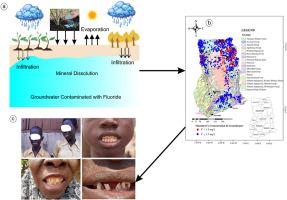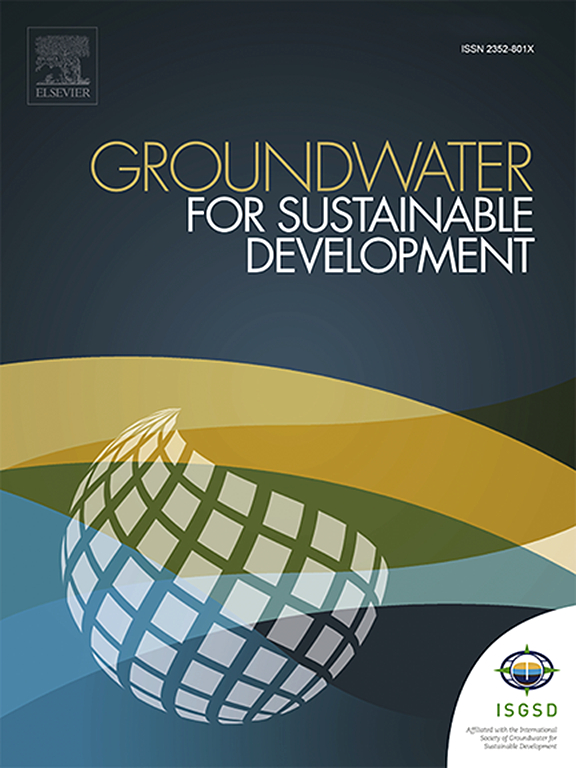Groundwater fluoride contamination, sources, hotspots, health hazards, and sustainable containment measures: A systematic review of the Ghanaian context
IF 4.9
Q2 ENGINEERING, ENVIRONMENTAL
引用次数: 0
Abstract
Groundwater quality is globally threatened by geogenic and human activities. These activities release high levels of potentially toxic elements, such as fluoride (F−), which pose significant threats to human health. This has become a global issue, especially in developing countries such as Ghana. Despite efforts to address this issue, knowledge gaps still need to be addressed to ensure safe and healthy drinking water for all Ghanaians. Moreover, Ghana has been reported to be a fluorosis-endemic country but the sources and exact hotspots of F− enrichment in the aquifers on a countrywide scale are lacking in the available literature. Understanding the quality of water used for diverse purposes in Ghana is necessary to achieve the United Nations Sustainable Development Goals like good health and well-being (SDG 3) and clean water and sanitation (SDG 6), among others. Therefore, this study synthesized all previous studies on groundwater F− contamination in Ghana, to identify the sources of F− enrichment in groundwater, delineate the hotspots for fluorosis, assess the associated human health risks, identify the best sustainable defluoridation methods, and recommend policy intervention for high groundwater F− threat to aquifers in Ghana. In the Ghanaian context, F− contamination in groundwater is largely from geogenic sources like the weathering of fluoride-bearing rocks (granitoids and carbonate sedimentary lithologies) from the Birimian and Voltaian Supergroups and the dissolution of fluoride-rich minerals (fluorapatite, amphiboles, fluorite, biotite, and muscovite). Hotspots for high groundwater F− in Ghana are mainly restricted to the Upper East Region (0.10–5.00 mg/L), North East Region (0.01–13.29 mg/L), Northern Region (0.1–11.6 mg/L), and the White Volta River Basin (0.04–3.79 mg/L). The mean and maximum values of F− in these hotspots exceed the maximum permissible level (1.5 mg/L) set by the World Health Organization and Ghana Standards Authority. Most people in these areas suffer from dental fluorosis. Therefore, affordable and sustainable defluoridation technologies as well as community-based initiatives are recommended to deal with this menace.

地下水氟污染、来源、热点、健康危害和可持续遏制措施:对加纳情况的系统回顾
地下水质量在全球范围内受到地质活动和人类活动的威胁。这些活动释放出高浓度的潜在有毒元素,如氟化物(F-),对人类健康构成严重威胁。这已成为一个全球性问题,尤其是在加纳等发展中国家。尽管为解决这一问题做出了努力,但仍需填补知识空白,以确保所有加纳人都能获得安全健康的饮用水。此外,据报道加纳是一个氟中毒流行的国家,但现有文献中缺乏全国范围内含水层中氟富集的来源和确切热点。要实现联合国可持续发展目标,如良好的健康和福祉(可持续发展目标 3)以及清洁水和卫生设施(可持续发展目标 6)等,就必须了解加纳各种用途的水质。因此,本研究综合了以往关于加纳地下水氟污染的所有研究,以确定地下水中氟富集的来源,划定氟中毒的热点地区,评估相关的人类健康风险,确定最佳的可持续除氟方法,并针对加纳地下水含氟过高对含水层造成的威胁提出政策干预建议。在加纳,地下水中的氟污染主要来自地质来源,如来自比里米亚超群和伏尔泰超群的含氟岩石(花岗岩和碳酸盐沉积岩质)的风化以及富氟矿物(氟磷灰石、闪石、萤石、黑云母和麝香石)的溶解。加纳地下水含氟量较高的热点地区主要限于上东部地区(0.10-5.00 毫克/升)、东北部地区(0.01-13.29 毫克/升)、北部地区(0.1-11.6 毫克/升)和白沃尔塔河流域(0.04-3.79 毫克/升)。这些热点地区的 F- 平均值和最大值都超过了世界卫生组织和加纳标准局规定的最大允许值(1.5 毫克/升)。这些地区的大多数人都患有氟斑牙。因此,建议采用负担得起、可持续的除氟技术以及基于社区的举措来应对这一威胁。
本文章由计算机程序翻译,如有差异,请以英文原文为准。
求助全文
约1分钟内获得全文
求助全文
来源期刊

Groundwater for Sustainable Development
Social Sciences-Geography, Planning and Development
CiteScore
11.50
自引率
10.20%
发文量
152
期刊介绍:
Groundwater for Sustainable Development is directed to different stakeholders and professionals, including government and non-governmental organizations, international funding agencies, universities, public water institutions, public health and other public/private sector professionals, and other relevant institutions. It is aimed at professionals, academics and students in the fields of disciplines such as: groundwater and its connection to surface hydrology and environment, soil sciences, engineering, ecology, microbiology, atmospheric sciences, analytical chemistry, hydro-engineering, water technology, environmental ethics, economics, public health, policy, as well as social sciences, legal disciplines, or any other area connected with water issues. The objectives of this journal are to facilitate: • The improvement of effective and sustainable management of water resources across the globe. • The improvement of human access to groundwater resources in adequate quantity and good quality. • The meeting of the increasing demand for drinking and irrigation water needed for food security to contribute to a social and economically sound human development. • The creation of a global inter- and multidisciplinary platform and forum to improve our understanding of groundwater resources and to advocate their effective and sustainable management and protection against contamination. • Interdisciplinary information exchange and to stimulate scientific research in the fields of groundwater related sciences and social and health sciences required to achieve the United Nations Millennium Development Goals for sustainable development.
 求助内容:
求助内容: 应助结果提醒方式:
应助结果提醒方式:


